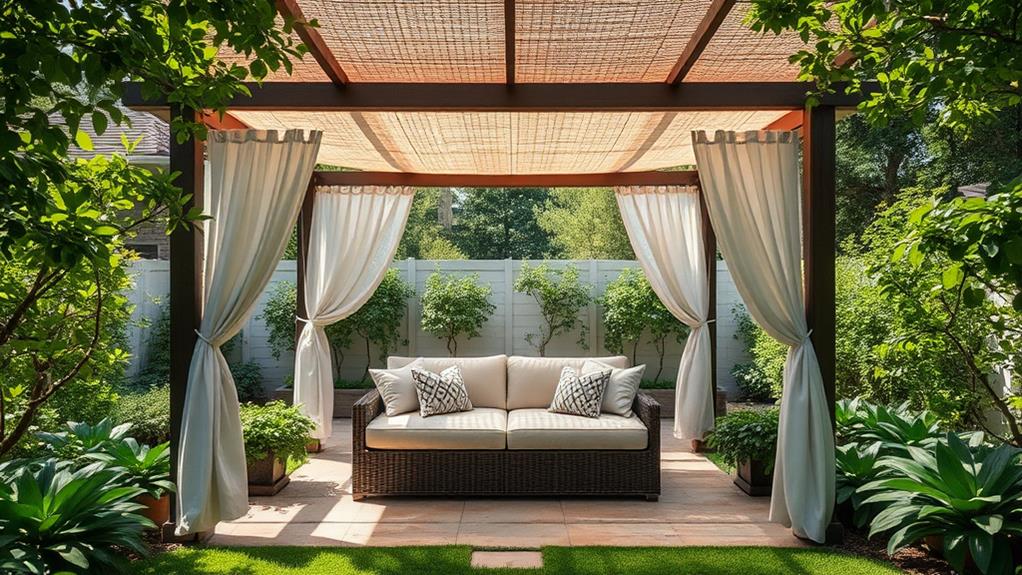Creating the perfect outdoor siesta spot involves thoughtful planning and design. Start by selecting a secluded location with ample shade and protection from the elements. Choose comfortable seating options like hammocks, daybeds, or chaise lounges to suit your preferences. Incorporate shade structures and weather-resistant fabrics for year-round comfort. Enhance the ambiance with soothing sensory elements like water features and aromatic plants. Prioritize privacy and noise reduction through strategic landscaping and acoustic solutions. Accessorize your napping nook with cozy cushions, throws, and ambient lighting. With careful consideration of these elements, you'll be well on your way to creating a tranquil outdoor retreat for ultimate relaxation.
Choosing the Ideal Location

Selecting the perfect spot for outdoor napping is crucial to creating a serene and comfortable environment. Consider factors such as privacy, noise levels, and exposure to natural elements when choosing your location. Opt for a secluded area in your yard, away from busy streets or noisy neighbors, to ensure uninterrupted rest.
Assess the amount of sunlight and shade throughout the day, as you'll want a balance to prevent overheating or excessive exposure. A spot under a mature tree or adjacent to a pergola can provide ideal shade coverage. Consider the direction of prevailing winds to avoid drafts, and ensure proper drainage to prevent moisture accumulation.
Proximity to your home is also important for convenience and easy access to amenities. Choose a location that's visible from inside for safety reasons, especially if you have children or pets. Consider the view from your napping spot, as a pleasant outlook can enhance relaxation. Finally, evaluate the ground surface – a level area with soft grass or a dedicated platform will provide the most comfort for your outdoor siesta space.
Comfortable Seating Options
To create an inviting outdoor napping space, comfortable seating options are essential. Consider a variety of choices that cater to different preferences and napping styles. Hammocks provide a classic, swaying relaxation experience and can be easily hung between trees or on a sturdy frame.
For a more substantial option, outdoor daybeds offer a luxurious feel and ample space for stretching out. Chaise lounges are versatile choices that allow for both sitting upright and reclining fully. Look for models with adjustable backs and weather-resistant cushions.
Oversized outdoor sofas or sectionals can accommodate multiple nappers and serve as multipurpose seating areas. For a bohemian touch, consider large floor pillows or bean bags designed for outdoor use. Hanging chairs or swing seats offer a cozy, nest-like feel and gentle motion.
Lastly, don't overlook the simple pleasure of a well-cushioned bench or glider. Whichever seating option you choose, prioritize comfort, durability, and weather resistance. Opt for materials like all-weather wicker, teak, or powder-coated aluminum, and select plush, quick-drying cushions with removable, washable covers to ensure longevity and easy maintenance of your outdoor napping haven.
Shade and Weather Protection

Shelter from the elements is paramount when creating an ideal outdoor napping space. To ensure comfort and protection, consider installing a pergola or gazebo with a retractable canopy. These structures offer adjustable shade and shelter from unexpected rain showers.
For a more budget-friendly option, large umbrellas or sail shades can provide ample coverage.
When selecting shade solutions, opt for materials that block harmful UV rays while allowing air circulation. Weather-resistant fabrics like Sunbrella are excellent choices for their durability and fade-resistant properties. To combat insects, incorporate mosquito netting or screens into your shade structure.
For year-round use, consider adding outdoor heaters or a fire pit nearby to extend the napping season into cooler months. Conversely, outdoor fans can provide a cooling breeze during hot summer days. To protect against wind, install windbreaks such as trellises with climbing plants or decorative screens.
Lastly, ensure proper drainage in your napping area to prevent water accumulation. Slightly elevated platforms or well-placed gravel can help manage rainwater and maintain a dry, comfortable space for your outdoor siesta.
Soothing Sensory Elements
Creating a soothing sensory environment is essential for an optimal outdoor napping experience. To achieve this, incorporate elements that engage multiple senses in a calming manner.
For sound, consider installing a small water feature, such as a fountain or bubbling rock, to provide a gentle, consistent background noise that masks disruptive sounds. Wind chimes can also add a subtle, melodic element to the space.
Aromatherapy can enhance relaxation through carefully selected plants or essential oil diffusers. Lavender, jasmine, and chamomile are known for their sleep-inducing properties. Tactile comfort is crucial, so invest in high-quality, weather-resistant cushions and throws with soft, breathable fabrics. Opt for cool-toned colors like blues and greens in your decor to create a visually calming atmosphere.
Gentle lighting can be achieved through solar-powered lanterns or string lights with warm-toned bulbs, providing a soft glow for early evening naps. Consider incorporating natural elements like smooth river rocks or a small zen garden to engage the sense of touch and promote mindfulness. By thoughtfully addressing each sense, you can create a tranquil outdoor napping space that promotes deep relaxation and rejuvenation.
Privacy and Noise Reduction

For a truly restful outdoor napping experience, privacy and noise reduction are paramount. To create a secluded environment, consider installing privacy screens, trellises with climbing plants, or strategically placed tall shrubs. These elements not only block unwanted views but also help absorb ambient noise.
Acoustic fencing is another effective option for reducing external sounds. These specialized fences are designed with sound-absorbing materials and can significantly decrease noise pollution from nearby roads or neighbors. For added privacy and noise reduction, consider constructing a pergola or gazebo with solid sides and a roof.
White noise generators or water features can mask disruptive sounds and create a soothing atmosphere. A small fountain or bubbling rock feature not only adds visual interest but also produces calming background noise. Weatherproof outdoor speakers can be used to play nature sounds or gentle music to further enhance the napping environment.
Lastly, consider the placement of your napping area. Position it away from high-traffic zones in your yard and neighboring properties to minimize disturbances. By implementing these privacy and noise reduction strategies, you can create a tranquil outdoor oasis perfect for rejuvenating naps.
Accessorizing Your Napping Nook
To transform your outdoor napping space into a cozy retreat, carefully chosen accessories play a crucial role. Start with comfortable seating options like a plush daybed, hammock, or reclining lounger. Add weather-resistant cushions and pillows in soothing colors and textures to enhance comfort and visual appeal.
Incorporate lightweight throws or blankets for temperature regulation during cooler moments. A small side table or built-in shelf can hold essentials like books, drinks, or sunscreen. Consider adding a umbrella or retractable awning for adjustable shade control.
Ambient lighting, such as string lights or solar-powered lanterns, can create a tranquil atmosphere for evening relaxation. Introduce calming elements like a small water feature or wind chimes for gentle background sounds. Potted plants or vertical gardens can provide natural beauty and improve air quality.
For convenience, install a charging station or weatherproof outlet nearby for electronic devices. Finally, include storage solutions like a weatherproof ottoman or decorative box to keep accessories organized and protected when not in use. These thoughtful additions will elevate your outdoor napping nook, making it a inviting sanctuary for rest and relaxation.
Frequently Asked Questions
How Can I Prevent Insects From Disturbing My Outdoor Naps?
To prevent insects from disturbing outdoor naps, consider using mosquito netting, applying insect repellent, and placing citronella candles nearby. Additionally, wear light-colored, long-sleeved clothing and choose a napping spot away from standing water or dense vegetation.
What's the Ideal Nap Duration for Outdoor Siestas?
Studies show that 34% of adults nap regularly. The ideal nap duration for outdoor siestas is typically 10-20 minutes. This short period allows for refreshment without entering deep sleep, which can lead to grogginess upon waking.
Are There Any Health Benefits Specific to Napping Outdoors?
Napping outdoors can offer unique health benefits, including increased vitamin D absorption, improved mood, and reduced stress levels. Exposure to natural light and fresh air may also enhance sleep quality and regulate circadian rhythms more effectively than indoor naps.
How Do I Maintain My Outdoor Napping Area During Off-Seasons?
To maintain your outdoor napping area during off-seasons, regularly clean and cover furniture, treat wooden surfaces, store cushions indoors, and trim surrounding vegetation. Perform periodic inspections for damage, address any pest issues, and ensure proper drainage to prevent water accumulation.
Can I Create a Suitable Napping Spot in a Small Urban Balcony?
Absolutely! Transform your tiny urban balcony into a colossal oasis of tranquility. Utilize space-saving furniture, roll-up mattresses, and hanging plants to create a compact yet luxurious napping nook. Add privacy screens and noise-canceling devices for ultimate relaxation.
Conclusion
In conclusion, the creation of an outdoor siesta paradise is nothing short of a revolutionary act in modern living. By meticulously crafting a haven of unparalleled comfort, shade, and tranquility, homeowners can unlock the secrets to ultimate relaxation. This transformative space, shielded from the chaos of the world, becomes a sanctuary where time stands still and stress evaporates. The outdoor napping nook, when executed with exquisite attention to detail, transcends mere renovation—it becomes a portal to blissful rejuvenation.

